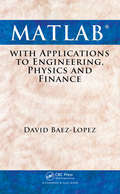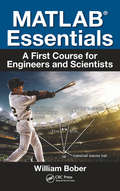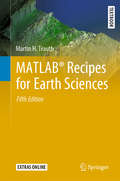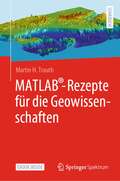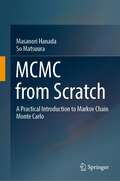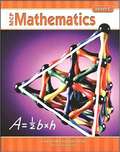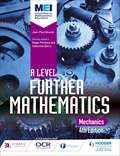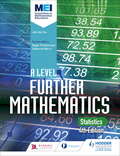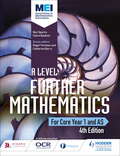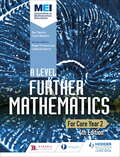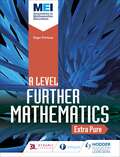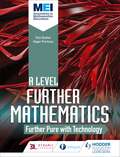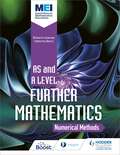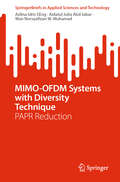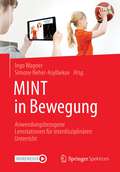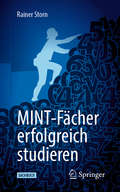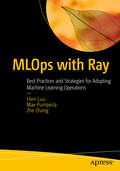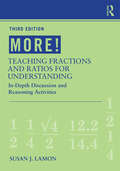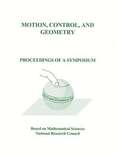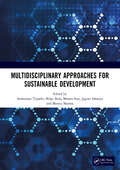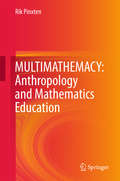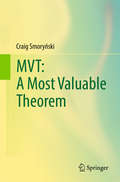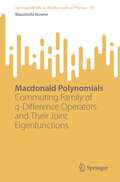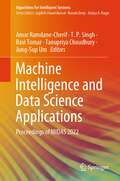- Table View
- List View
MATLAB with Applications to Engineering, Physics and Finance
by David Baez-LopezMaster the tools of MATLAB through hands-on examplesShows How to Solve Math Problems Using MATLABThe mathematical software MATLAB integrates computation, visualization, and programming to produce a powerful tool for a number of different tasks in mathematics. Focusing on the MATLAB toolboxes especially dedicated to science, finance, and engineering
MATLAB® Essentials: A First Course for Engineers and Scientists
by William BoberAll disciplines of science and engineering use numerical methods for complex problem analysis, due to the highly mathematical nature of the field. Analytical methods alone are unable to solve many complex problems engineering students and professionals confront. Introduction to MATLAB® Programming for Engineers and Scientists examines the basic elements of code writing, and describes MATLAB® methods for solving common engineering problems and applications across the range of engineering disciplines. The text uses a class-tested learning approach and accessible two-color page design to guide students from basic programming to the skills needed for future coursework and engineering practice.
MATLAB® Recipes for Earth Sciences: Matlab® And Design Recipes For Earth Sciences (Springer Textbooks in Earth Sciences, Geography and Environment)
by Martin H. TrauthMATLAB® is used in a wide range of geoscientific applications, e.g. for image processing in remote sensing, for creating and processing digital elevation models, and for analyzing time series. This book introduces readers to MATLAB-based data analysis methods used in the geosciences, including basic statistics for univariate, bivariate and multivariate datasets, time-series analysis, signal processing, the analysis of spatial and directional data, and image analysis. The revised and updated Fifth Edition includes seven new sections, and the majority of the chapters have been rewritten and significantly expanded. New sections include error analysis, the problem of classical linear regression of log-transformed data, aligning stratigraphic sequences, the Normalized Difference Vegetation Index, Aitchison’s log-ratio transformation, graphical representation of spherical data, and statistics of spherical data. The book also includes numerous examples demonstrating how MATLAB can be used on datasets from the earth sciences. The supplementary electronic material (available online through SpringerLink) contains recipes that include all the MATLAB commands featured in the book and the sample data.
MATLAB®-Rezepte für die Geowissenschaften
by Martin H. TrauthTrauth, Martin H.MATLAB® - Rezepte für Geowissenschaften, 1. deutschsprachige Auflage, basierend auf der korrigierten 5. englischsprachigen AuflageMATLAB® wird in einer Vielzahl von geowissenschaftlichen Anwendungen eingesetzt, z.B. zur Bildverarbeitung in der Fernerkundung, zur Erzeugung und Verarbeitung digitaler Höhenmodelle und zur Analyse von Zeitreihen. Dieses Buch führt in Methoden der Datenanalyse in den Geowissenschaften mit MATLAB ein, wie z.B. grundlegende Statistik für univariate, bivariate und multivariate Datensätze, Zeitreihenanalyse, Signalverarbeitung, die Analyse räumlicher und gerichteter Daten und Bildanalyse. Der Text enthält zahlreiche Beispiele, die zeigen, wie MATLAB auf Datensätze aus den Geowissenschaften angewendet werden kann. Das ergänzende elektronische Material des Buches (online verfügbar über Springer Link) enthält Rezepte, die alle im Buch vorgestellten MATLAB-Befehle und die Beispieldaten enthalten. Das Buch soll Student:innen, Doktorand:innen, Postdoktorand:innen und Fachleuten helfen, schnelle Lösungen für gängige Datenanalyseprobleme in den Geowissenschaften zu finden.SystemanforderungenBenutzer:innen dieses Buches benötigen die MATLAB®-Software, die für Windows, macOS und Linux verfügbar ist. Die M-Files und Beispieldaten, die online über Springer Link verfügbar sind, sollten auf allen Plattformen laufen, ohne dass eine Modifikation erforderlich ist. Für diese Ausgabe haben wir MATLAB Version 9.11 (Release 2021b), die Bioinformatics Toolbox Version 4.15.2, die Image Processing Toolbox Version 11.4, die Mapping Toolbox Version 5.2, die Signal Processing Toolbox Version 8.7, Simulink 3D Animation Version 9.3, die Statistics and Machine Learning Toolbox Version 12.2 und die Wavelet Toolbox Version 6.0 verwendet.
MCMC from Scratch: A Practical Introduction to Markov Chain Monte Carlo
by Masanori Hanada So MatsuuraThis textbook explains the fundamentals of Markov Chain Monte Carlo (MCMC) without assuming advanced knowledge of mathematics and programming. MCMC is a powerful technique that can be used to integrate complicated functions or to handle complicated probability distributions. MCMC is frequently used in diverse fields where statistical methods are important – e.g. Bayesian statistics, quantum physics, machine learning, computer science, computational biology, and mathematical economics. This book aims to equip readers with a sound understanding of MCMC and enable them to write simulation codes by themselves. The content consists of six chapters. Following Chap. 2, which introduces readers to the Monte Carlo algorithm and highlights the advantages of MCMC, Chap. 3 presents the general aspects of MCMC. Chap. 4 illustrates the essence of MCMC through the simple example of the Metropolis algorithm. In turn, Chap. 5 explains the HMC algorithm, Gibbs sampling algorithm and Metropolis-Hastings algorithm, discussing their pros, cons and pitfalls. Lastly, Chap. 6 presents several applications of MCMC. Including a wealth of examples and exercises with solutions, as well as sample codes and further math topics in the Appendix, this book offers a valuable asset for students and beginners in various fields.
MCP Mathematics, Level E
by Dale Seymour Publications<p>MCP Mathematics promotes mathematical success for all students, especially those who struggle with their core math program. This trusted, targeted program uses a traditional drill and practice format with a predictable, easy-to-use lesson format. MCP Math is flexible and adaptable to fit a variety of intervention settings including after school, summer school, and additional math instruction during the regular school day. </p>
MEI A Level Further Mathematics Mechanics 4th Edition
by Jean-Paul MuscatExam Board: MEILevel: A-levelSubject: MathematicsFirst Teaching: September 2017First Exam: June 2018An OCR endorsed textbookHelp students to develop their knowledge and apply their reasoning to mathematical problems with textbooks that draw on the well-known MEI (Mathematics in Education and Industry) series, updated and tailored to the 2017 OCR (MEI) specification and developed by subject experts and MEI.- Ensure targeted development of reasoning and problem-solving skills with plenty of practice questions and structured exercises that build mathematical skills and techniques.- Build connections between topics, using real-world contexts to help develop mathematical modelling skills, thus providing a fuller and more coherent understanding of mathematical concepts.- Help students to overcome misconceptions and develop insight into problem solving with annotated worked examples.- Develop understanding and measure progress with graduated exercises that support students at every stage of their learning.- Provide clear paths of progression that combine pure and applied maths into a coherent whole.
MEI A Level Further Mathematics Statistics 4th Edition
by John du FeuExam Board: MEILevel: A-levelSubject: MathematicsFirst Teaching: September 2017First Exam: June 2018Help students to develop their knowledge and apply their reasoning to mathematical problems with textbooks that draw on the well-known MEI (Mathematics in Education and Industry) series, updated and tailored to the 2017 OCR (MEI) specification and developed by subject experts and MEI.- Ensure targeted development of reasoning and problem-solving skills with plenty of practice questions and structured exercises that build mathematical skills and techniques.- Build connections between topics, using real-world contexts to help develop mathematical modelling skills, thus providing a fuller and more coherent understanding of mathematical concepts.- Help students to overcome misconceptions and develop insight into problem solving with annotated worked examples.- Develop understanding and measure progress with graduated exercises that support students at every stage of their learning.- Provide clear paths of progression that combine pure and applied maths into a coherent whole.
MEI A Level Further Mathematics Year 1 (AS) 4th Edition
by Ben Sparks Claire BaldwinExam Board: MEILevel: A-levelSubject: MathematicsFirst Teaching: September 2017First Exam: June 2018An OCR endorsed textbookHelp students to develop their knowledge and apply their reasoning to mathematical problems with textbooks that draw on the well-known MEI (Mathematics in Education and Industry) series, updated and tailored to the 2017 OCR (MEI) specification and developed by subject experts and MEI.- Ensure targeted development of reasoning and problem-solving skills with plenty of practice questions and structured exercises that build mathematical skills and techniques.- Build connections between topics, using real-world contexts to help develop mathematical modelling skills, thus providing a fuller and more coherent understanding of mathematical concepts.- Address the new statistics requirements with five dedicated statistics chapters and questions around the use of large data sets. - Help students to overcome misconceptions and develop insight into problem solving with annotated worked examples.- Develop understanding and measure progress with graduated exercises that support students at every stage of their learning.- Provide clear paths of progression that combine pure and applied maths into a coherent whole.
MEI A Level Further Mathematics Year 2 4th Edition
by Ben Sparks Claire BaldwinHelp students to develop their knowledge and apply their reasoning to mathematical problems with textbooks that draw on the well-known MEI (Mathematics in Education and Industry) series, updated and tailored to the 2017 OCR (MEI) specification and developed by subject experts and MEI.- Ensure targeted development of reasoning and problem-solving skills with plenty of practice questions and structured exercises that build mathematical skills and techniques.- Build connections between topics, using real-world contexts to help develop mathematical modelling skills, thus providing a fuller and more coherent understanding of mathematical concepts.- Address the new statistics requirements with five dedicated statistics chapters and questions around the use of large data sets. - Help students to overcome misconceptions and develop insight into problem solving with annotated worked examples.- Develop understanding and measure progress with graduated exercises that support students at every stage of their learning.- Provide clear paths of progression that combine pure and applied maths into a coherent whole.- Reinforce Year 1 content with short review chapters - Core FM Year 2 only.
MEI A Level Mathematics Year 2 4th Edition
by Val Hanrahan Sophie Goldie Cath Moore Jean-Paul Muscat Susan WhitehouseExam Board: MEILevel: A-levelSubject: MathematicsFirst Teaching: September 2018First Exam: June 2019An OCR endorsed textbookEncourage every student to develop a deeper understanding of mathematical concepts and their applications with textbooks that draw on the well-known MEI (Mathematics in Education and Industry) series, updated and tailored to the 2017 OCR (MEI) specification and developed by subject experts and MEI.- Develop problem-solving, proof and modelling skills with plenty of questions and well-structured exercises that build skills and mathematical techniques.- Build connections between topics, using real-world contexts to help develop mathematical modelling skills, thus providing a fuller and more coherent understanding of mathematical concepts.- Prepare students for assessment with practice questions written by subject experts.- Ensure coverage of the new statistics requirements with five dedicated statistics chapters and questions around the use of large data sets. - Supports the use of technology with a variety of questions based around the use of spreadsheets, graphing software and graphing calculators. - Provide clear paths of progression that combine pure and applied maths into a coherent whole.- Reinforce Year 1 content with short review chapters - Year 2 only.
MEI Further Maths: Extra Pure Maths
by David BedfordDevelop a deeper understanding of mathematical concepts and their applications with new and updated editions from our bestselling series.- Build connections between topics using real-world contexts that develop mathematical modelling skills, thus providing your students with a fuller and more coherent understanding of mathematical concepts.- Develop fluency in problem-solving, proof and modelling with plenty of questions and well-structured exercises.- Overcome misconceptions and develop mathematical insight with annotated worked examples.- Enhance understanding and map your progress with graduated exercises that support you at every stage of your learning.
MEI Further Maths: Further Pure Maths with Technology
by Tom ButtonDevelop a deeper understanding of mathematical concepts and their applications with new and updated editions from our bestselling series.- Build connections between topics using real-world contexts that develop mathematical modelling skills, thus providing your students with a fuller and more coherent understanding of mathematical concepts.- Develop fluency in problem-solving, proof and modelling with plenty of questions and well-structured exercises.- Overcome misconceptions and develop mathematical insight with annotated worked examples.- Enhance understanding and map your progress with graduated exercises that support you at every stage of your learning.
MEI Further Maths: Numerical Methods
by Richard LissamanDevelop a deeper understanding of mathematical concepts and their applications with new and updated editions from our bestselling series.- Build connections between topics using real-world contexts that develop mathematical modelling skills, thus providing your students with a fuller and more coherent understanding of mathematical concepts.- Develop fluency in problem-solving, proof and modelling with plenty of questions and well-structured exercises.- Overcome misconceptions and develop mathematical insight with annotated worked examples.- Enhance understanding and map your progress with graduated exercises that support you at every stage of your learning.
MIMO-OFDM Systems with Diversity Technique: PAPR Reduction (SpringerBriefs in Applied Sciences and Technology)
by Azlina Idris CEng Aidatul Julia Jabar Wan Norsyafizan MuhamadThis book addresses the challenges in wireless communication, particularly focusing on the high Peak-to-Average Power Ratio (PAPR) in MIMO-OFDM systems. As the demand for high-speed, reliable wireless communication continues to evolve, this book provides an in-depth exploration of Orthogonal Frequency Division Multiplexing (OFDM) and Multiple Input Multiple Output (MIMO) technologies, which are essential for modern telecommunications. Readers will find particular interest in the innovative PAPR reduction techniques discussed, which are categorized into signal distortion, coding, and probabilistic methods. These techniques not only aim to mitigate the PAPR issue but also enhance the overall efficiency of wireless systems. The book includes various illustrations, tables, and a structured improving approach, making complex concepts accessible and engaging. The main benefit for readers is the practical application of these techniques, which can lead to improved performance in wireless networks, particularly for telecommunications companies in search of optimizing the systems. This book serves as a valuable resource for researchers and practitioners, providing insights into the latest advancements in PAPR reduction and its implications for future wireless communication technologies.
MINT in Bewegung: Anwendungsbezogene Lernstationen für interdisziplinären Unterricht
by Ingo Wagner Simone Neher-AsylbekovFür viele Herausforderungen der modernen Gesellschaft ist ein vernetztes und fachübergreifendes Denken notwendig. Damit Referendar*innen und Lehrkräfte diese fachübergreifende Denkweise besser in den Unterricht einbringen können, werden in diesem Buch 13 umfangreich aufbereitete und interdisziplinäre Lerneinheiten vorgestellt.Sie ermöglichen einen innovativen Zugang durch die Verknüpfung von MINT-Inhalten (Mathematik, Informatik, Naturwissenschaften und Technik) mit sportlichen Bewegungen, die die Lernenden am eigenen Körper direkt erfahren können. Hierfür sind die Lerneinheiten in Stationen organisiert und enthalten fundierte Sachanalysen. Zudem werden ausführliche didaktische Hintergründe, wie z. B. antizipierte Ergebnisse, mögliche Probleme und Differenzierungsoptionen, bereitgestellt. Zusätzliche Materialien, wie beispielsweise Lösungsblätter, sind ergänzend kostenlos online abrufbar. Die Lerneinheiten stammen aus dem Schülerlabor „MINT in Bewegung“ am Karlsruher Institut für Technologie (KIT) und bereichern den Unterricht durch spannende Versuche sowie praktisches Arbeiten mit naturwissenschaftlichen Methoden und Messgeräten. Sie eignen sich für Schüler*innen der Sekundarstufe 1 aller Schulformen. Für Lehrkräfte ergibt sich hierdurch eine innovative Möglichkeit, traditionelle Lehrmethoden um neue Perspektiven zu erweitern.
MINT-Fächer erfolgreich studieren
by Rainer StornSie haben vor, ein MINT-Fach zu studieren und dabei das bestmögliche Ergebnis für Ihren Einsatz zu bekommen? Dann erfahren Sie hier, wie die richtigen Verhaltensweisen, Lernstrategien und organisatorischen Feinheiten Ihr Studienergebnis verbessern können, indem Sie die richtigen Dinge tun und keine Energie auf Unnötiges verschwenden. Lernen Sie:Was Sie tun müssen, wenn Sie in der Vorlesung abgehängt werdenWie Sie optimal lernen und das nötige Wissen effizient in Ihrem Gedächtnis verankernWie Sie sich strategisch auf eine Prüfung vorbereiten, so wie ein Spitzensportler auf die MeisterschaftWie Sie in der Prüfung die Nervosität dämpfen und die Prüfungszeit am effizientesten nutzenWie Sie Ihre Abschlussarbeit systematisch zu guter Qualität führenWie Sie Ihre Arbeit interessant und überzeugend präsentierenUnd welche Dinge im Vorstellungsgespräch besonders wichtig sind Dieses Buch wird Ihnen nicht nur helfen, Ihr Studium so effizient wie möglich zu gestalten. Es zeigt Ihnen auch zahlreiche Vorgehensweisen, die während Ihrer gesamten beruflichen Laufbahn wichtig sein werden und in vielen Fällen für Ihren Erfolg sogar unabdingbar sind.
MLOps with Ray: Best Practices and Strategies for Adopting Machine Learning Operations
by Max Pumperla Zhe Zhang Hien LuuUnderstand how to use MLOps as an engineering discipline to help with the challenges of bringing machine learning models to production quickly and consistently. This book will help companies worldwide to adopt and incorporate machine learning into their processes and products to improve their competitiveness. The book delves into this engineering discipline's aspects and components and explores best practices and case studies. Adopting MLOps requires a sound strategy, which the book's early chapters cover in detail. The book also discusses the infrastructure and best practices of Feature Engineering, Model Training, Model Serving, and Machine Learning Observability. Ray, the open source project that provides a unified framework and libraries to scale machine learning workload and the Python application, is introduced, and you will see how it fits into the MLOps technical stack. This book is intended for machine learning practitioners, such as machine learning engineers, and data scientists, who wish to help their company by adopting, building maps, and practicing MLOps. What You'll Learn Gain an understanding of the MLOps discipline Know the MLOps technical stack and its components Get familiar with the MLOps adoption strategy Understand feature engineering Who This Book Is For Machine learning practitioners, data scientists, and software engineers who are focusing on building machine learning systems and infrastructure to bring ML models to production
MORE! Teaching Fractions and Ratios for Understanding: In-Depth Discussion and Reasoning Activities
by Susan J. LamonMore is not an answer key but a resource that provides the scaffolding for the groundbreaking approach to fraction and ratio instruction presented in its companion text, Teaching Fractions and Ratios. Keeping the focus on the reasoning needed to properly understand and teach rational numbers, More shows teachers how to engage in powerful ways of thinking so that they can, in turn, enhance the mathematical education of their students. Like its companion text, More has been heavily expanded and reorganized, including even more student work, templates for key manipulatives, and an emphasis on applications to everyday life. Based on the content chapters in Teaching Fractions and Ratios, each chapter includes: In-depth Discussions of selected problems and their solutions. Supplementary Activities and a collection of challenging problems involving fractions. Praxis Preparation Questions geared to the content of each chapter.
MOTION, CONTROL, AND GEOMETRY: Proceedings of a Symposium
by Board on Mathematical SciencesProceedings of a Symposium on Motion, Control, and Geometry
MULTIDISCIPLINARY APPROACHES FOR SUSTAINABLE DEVELOPMENT: International Conference on MULTIDISCIPLINARY APPROACHES FOR SUSTAINABLE DEVELOPMENT IN SCIENCE & TECHNOLOGY
by Monica Sharma Shilpi Birla Anshuman Tripathi Jagrati Sahariya Mamta SoniIn a world where the pace of technological advancement continues to accelerate, the imperative to ensure sustainable development has never been more pressing to address the same, the 1st International Conference on Multidisciplinary Approaches for Sustainable Development in Science & Technology (MASDST - 2024), took place at Manipal University Jaipur, Rajasthan, India, from 28th to 29th March 2024. Embracing the spirit of innovation and collaboration, this conference marks a significant milestone in the pursuit of sustainable solutions for our global challenges.
MULTIMATHEMACY: Anthropology and Mathematics Education
by Rik PinxtenThis book defends that math education should systematically start out from the diverse out-of-school knowledge of children and develop trajectories from there to the Academic Mathematics tower of knowledge. Learning theories of the sociocultural school (Vygotsky and on) are used here, and ethnographic knowledge from around the world is shown to offer a rich and varied base for curricula. The book takes a political stand against the exclusively western focus in OECD analyses and proposals on math education. This book aimsat agents in education and social actions in every cultural environment. But itis also attractive to mathematicians, anthropologists and other specialists. Itoffers a broad and scholarly view of knowledge and culture and a veryoriginal transcultural and transdisciplinarian approach to education. Ubiratan D'Ambrosio, UNICAMP/Universidade Estadual de Campinas, Brazil
MVT: A Most Valuable Theorem
by Craig SmorynskiThis book is about the rise and supposed fall of the mean value theorem. It discusses the evolution of the theorem and the concepts behind it, how the theorem relates to other fundamental results in calculus, and modern re-evaluations of its role in the standard calculus course. The mean value theorem is one of the central results of calculus. It was called "the fundamental theorem of the differential calculus" because of its power to provide simple and rigorous proofs of basic results encountered in a first-year course in calculus. In mathematical terms, the book is a thorough treatment of this theorem and some related results in the field; in historical terms, it is not a history of calculus or mathematics, but a case study in both. MVT: A Most Valuable Theorem is aimed at those who teach calculus, especially those setting out to do so for the first time. It is also accessible to anyone who has finished the first semester of the standard course in the subject and will be of interest to undergraduate mathematics majors as well as graduate students. Unlike other books, the present monograph treats the mathematical and historical aspects in equal measure, providing detailed and rigorous proofs of the mathematical results and even including original source material presenting the flavour of the history.
Macdonald Polynomials: Commuting Family of q-Difference Operators and Their Joint Eigenfunctions (SpringerBriefs in Mathematical Physics #50)
by Masatoshi NoumiThis book is a volume of the Springer Briefs in Mathematical Physics and serves as an introductory textbook on the theory of Macdonald polynomials. It is based on a series of online lectures given by the author at the Royal Institute of Technology (KTH), Stockholm, in February and March 2021. Macdonald polynomials are a class of symmetric orthogonal polynomials in many variables. They include important classes of special functions such as Schur functions and Hall–Littlewood polynomials and play important roles in various fields of mathematics and mathematical physics. After an overview of Schur functions, the author introduces Macdonald polynomials (of type A, in the GLn version) as eigenfunctions of a q-difference operator, called the Macdonald–Ruijsenaars operator, in the ring of symmetric polynomials. Starting from this definition, various remarkable properties of Macdonald polynomials are explained, such as orthogonality, evaluation formulas, and self-duality, with emphasis on the roles of commuting q-difference operators. The author also explains how Macdonald polynomials are formulated in the framework of affine Hecke algebras and q-Dunkl operators.
Machine Intelligence and Data Science Applications: Proceedings of MIDAS 2022 (Algorithms for Intelligent Systems)
by T. P. Singh Jung-Sup Um Tanupriya Choudhury Ravi Tomar Amar Ramdane-CherifThis book is a compilation of peer-reviewed papers presented at the International Conference on Machine Intelligence and Data Science Applications (MIDAS 2022), held on October 28 and 29, 2022, at the University of Versailles—Paris-Saclay, France. The book covers applications in various fields like data science, machine intelligence, image processing, natural language processing, computer vision, sentiment analysis, and speech and gesture analysis. It also includes interdisciplinary applications like legal, healthcare, smart society, cyber-physical system, and smart agriculture. The book is a good reference for computer science engineers, lecturers/researchers in the machine intelligence discipline, and engineering graduates.
